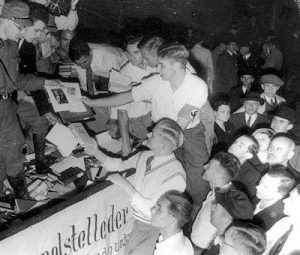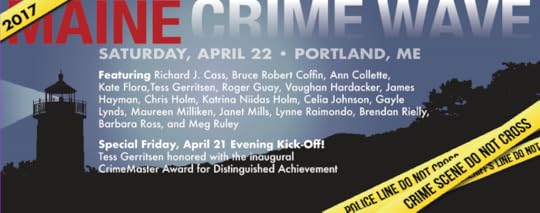Kathy Lynn Emerson's Blog, page 48
March 27, 2017
Is The 1st Amendment In Jeopardy?
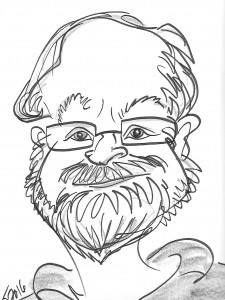
Vaughn
After reading Lea’s post of March 17, I have been giving a lot of thought to the question: “Where do you get your ideas?” We always respond that there are many sources from the media to our life experiences. It has led me to consider what might happen if we lost our freedom to express our personal, religious, and political beliefs.
Of late the news has been disturbing. I’m not alluding to the results of the current election, but about the state of our institutes of higher education. When I was a college student the environment encouraged us to think and if someone disagreed with our point of view at least listen and respect them. This doesn’t seem to be the case today. What disturbs me more is that this is not unique to modern times or to the United States. The first thing an autocratic dictator does is to stifle any opposition, both written and verbal. The most blatant example of this was in 1930s Germany.
On the night of May 10, 1933, an event unseen in Europe since the Middle Ages occurred as German students from universities once regarded as among the finest in the world, gathered in Berlin to burn books with “unGerman” ideas.
The students, along with brownshirted storm troopers, tossed heaps of books into a bonfire while giving the Hitler arm-salute and singing Nazi anthems. Among the 20,000 volumes hurled into the flames were the writings of Henri Barbusse, Franz Boas, John Dos Passos, Albert Einstein, Lion Feuchtwanger, Friedrich Förster, Sigmund Freud, John Galsworthy, André Gide, Ernst Glaeser, Maxim Gorki, Werner Hegemann, Ernest Hemingway, Erich Kästner, Helen Keller, Alfred Kerr, Jack London, Emil Ludwig, Heinrich Mann, Thomas Mann, Karl Marx, Hugo Preuss, Marcel Proust, Erich Maria Remarque, Walther Rathenau, Margaret Sanger, Arthur Schnitzler, Upton Sinclair, Kurt Tucholsky, Jakob Wassermann, H.G. Wells, Theodor Wolff, Emilé Zola, Arnold Zweig, and Stefan Zweig.
Propaganda Minister Joseph Goebbels joined the students at the bonfire and declared: “The era of extreme Jewish intellectualism is now at an end…The future German man will not just be a man of books, but a man of character. It is to this end that we want to educate you. As a young person, to already have the courage to face the pitiless glare, to overcome the fear of death, and to regain respect for death – this is the task of this young generation. And thus you do well in this midnight hour to commit to the flames the evil spirit of the past. This is a strong, great and symbolic deed – a deed which should document the following for the world to know – Here the intellectual foundation of the November [Democratic] Republic is sinking to the ground, but from this wreckage the phoenix of a new spirit will triumphantly rise…”
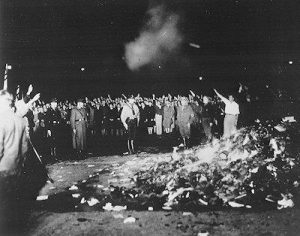
German Students Burn Books with unGerman content.
Germany was now led by a self-educated, high school drop-out named Adolf Hitler, who was by nature strongly anti-intellectual. For Hitler, the reawakening of the long-dormant Germanic spirit, with its racial and militaristic qualities, was far more important than any traditional notions of learning.
Before Hitler, German university towns had been counted among the world’s great centers of scientific innovation and literary scholarship. Under Hitler, Germany’s intellectual vitality quickly began to diminish. Truth, rational thinking and objective knowledge, the foundation stones of Western Civilization, were denounced by Nazified students and professors in favor of mysticism, speculation and collective thinking toward a common goal – the pursuit of a glorious future for Germany.
The youth-oriented Nazi movement had always attracted a sizable following among right-leaning university students. Even back in the 1920s they sensed Nazism might be the wave of the future. They joined the National Socialist German Students’ League, put on swastika armbands and harassed any anti-Nazi teachers.
Now, many formerly reluctant professors were swept along by the outpouring of student enthusiasm that followed Hitler’s seizure of power. Most of the professors eagerly surrendered their intellectual honesty and took the required Nazi oath of allegiance. They also wanted to curry favor with Nazi Party officials in order to grab one of the academic vacancies resulting from the mass expulsion of Jewish professors and deans.
The entire teaching profession throughout Germany, from elementary schools to university level, had been purged of Jewish instructors and anyone deemed politically suspect, regardless of their proven teaching abilities or achievements, including 20 past (and future) Nobel Prize winners. About ten percent of Germany’s university teaching force was sacked in 1933-34, with devastating results for disciplines such as quantum physics and mathematics where Jews had been prominent. The world’s premier physicist, Albert Einstein, settled in the United States along with many other intellectual refugees from Hitler’s Germany.
Lovers of truth and freedom who remained behind in Germany only managed to escape through the phenomenon of inner-emigration. The Nazis could never actually know one’s inner-most thoughts as long as one maintained a kind of poker face and didn’t reveal those private thoughts. However, this could also be a dreadfully lonely existence.
Eventually, small groups of like-minded students and professors still opposed to Nazism found each other. They sometimes held clandestine off-campus discussions featuring a free exchange of ideas. One such group based at the University of Munich became known as the White Rose and boldly distributed leaflets demanding that Hitler “return to us the personal freedom which is the most valuable possession of each German, and of which he has cheated us in the lowest possible manner.” Two members of the group, Hans and Sophie Scholl, were arrested by the Gestapo for this and executed.

German Students Gathering Books That disagree with Nazi Propaganda
In the college classroom, professors gave lectures amid the nagging fear they might be denounced by one of their students for any reason and possibly wind up in a concentration camp. Politically ambitious teachers sometimes kept secret dossiers on the utterances and activities of their fellow educators which could be turned over to the Gestapo to further their own careers. The widespread insecurity that resulted caused academic timidity which further lowered educational standards.
Grammar schools and high schools throughout Germany now had National Socialist teachers of questionable ability forming young minds in strict adherence to the Party motto: “The supreme task of the schools is the education of youth for the service of Volk and State in the National Socialist spirit.” They taught Nazi propaganda as truth and had their young students recite it back from memory.
In this New Order, anyone refusing to conform was simply removed from society and sent away for a special kind of re-education within the confines of a concentration camp. There they would be broken physically, mentally and spiritually until they either submitted completely or died. The first such camp was Dachau located near Munich. It was so successful that it became the model for all subsequent concentration camps, and there would be hundreds of them.
We Americans have a tendency to ignore impending threats by burying our heads in the sand like an ostrich. Lets take a few minutes to think about the atmosphere of intolerance that seems to pervade our colleges and universities today. Professors encourage students to attend protests (many of which have turned into violent riots) rather than class and in many cases join them in those protests which have a single purpose, to suppress the communication of ideas that disagree with their personal beliefs. There have been reports of faculty members telling students that if they vote a certain way they will be given an F. I am very concerned when I see speakers disrupted by protesters and hecklers when they hold a talk or town hall. If you don’t agree with a speaker, do the people who came to hear what he or she has to say a favor: STAY AWAY! At the very least challenge the speaker during the question and answer period of the talk by asking an intelligent and well thought out question.
As a veteran who spent eight years of his life defending the rights given us by our U. S. Constitution this disturbs me greatly. I have seen what happens to a country when a given philosophy becomes THE philosophy. So all that said, here’s my question. Do we as freedom-loving Americans want to spend thousands of dollars in tuition (not to mention the huge amounts of student loan debt) to have our youth, the leaders of tomorrow, indoctrinated and told what to think rather than how to think? Is there a chance that the freedoms given us in the 1st Amendment will be taken away or restricted? Is there a burning of the books in our future?
Overload
 Jessie: Still surrounded by snowbanks
Jessie: Still surrounded by snowbanks
It feels to me like I’ve spent the last few weeks awash in email. Every day I make a to do list and it seems as though half the items on it are emails that need answering. That doesn’t take into account all the emails that simply require discarding. Or the email trash bin that needs dumping. Or the unsubscribing from junk email lists.
By the time I’ve waded through it all I feel ready to leave my desk for the day. Which doesn’t result in a great deal of creative output. So, I’ve started seriously thinking about strategies for managing it all. Every month I pick a new skill or habit to work on and for the month of April I’ve decided to tackle the email monster. I’ve mulled and pondered and considered many options. What I’ve come up with is the idea of scheduling regular deliveries.
It used to be that the post was delivered no more than twice a day. As much as I might like to think otherwise, I’m not nearly important enough to need to be constantly available to whomever needs to reach me. Twice a day post would have been more than sufficient. Is there really any reason email should be different? Not for me there isn’t.
It isn’t going to be easy and I don’t expect to succeed right away, but I’m going to try to reduce my email checks to three or four times a day. It may take me longer to respond than senders would prefer but I think it will increase my creative output and leave me feeling accomplished at the end of the day rather than like I’ve simply been putting out fires that had no business flaring up in the first place.
Readers, do you have a any suggestions for how to deal with email?
March 24, 2017
Weekend Update: March 25-26, 2017
 Next week at Maine Crime Writers, there will be posts by Jessie Crockett (Monday) Vaughn Hardacker (Tuesday), Maureen Milliken (Wednesday), and John Clark (Thursday), and on Friday we will have a group post to update our Works in Progress.
Next week at Maine Crime Writers, there will be posts by Jessie Crockett (Monday) Vaughn Hardacker (Tuesday), Maureen Milliken (Wednesday), and John Clark (Thursday), and on Friday we will have a group post to update our Works in Progress.
In the news department, here’s what’s happening with some of us who blog regularly at Maine Crime Writers:
 From Kaitlyn Dunnett/Kathy Lynn Emerson: For anyone on Goodreads, I’m giving away five signed copies of the hardcover edition of Murder in a Cornish Alehouse (U.S. publication date April 1). Follow the link below to enter the drawing, which ends on Monday. This is the third book in the Mistress Jaffrey series and takes Rosamond and Rob to Cornwall, Lundy Island, and Ireland in 1584. There are pirates, smugglers, spies, a treason plot (real but all-but-forgotten by history, my favorite kind) and, of course, murder.
From Kaitlyn Dunnett/Kathy Lynn Emerson: For anyone on Goodreads, I’m giving away five signed copies of the hardcover edition of Murder in a Cornish Alehouse (U.S. publication date April 1). Follow the link below to enter the drawing, which ends on Monday. This is the third book in the Mistress Jaffrey series and takes Rosamond and Rob to Cornwall, Lundy Island, and Ireland in 1584. There are pirates, smugglers, spies, a treason plot (real but all-but-forgotten by history, my favorite kind) and, of course, murder.
 The Maine Crime Wave this year will honor Tess Gerritsen with its inaugural CrimeMaster Award. Fellow New York Times-bestselling author Gayle Lynds will introduce Gerritsen at the ceremony Friday, April 21 at 5:30 p.m. at USM’s Glickman Library in Portland. On Saturday morning, Tess will be joined by her renowned New York literary agent Meg Ruley of the Jane Rotrosen Agency for a discussion about the process of developing from debut author to New York Times bestseller. If you’ve been on the fence about the Maine Crime Wave, the time to jump in is now. Click on this link for more information.
The Maine Crime Wave this year will honor Tess Gerritsen with its inaugural CrimeMaster Award. Fellow New York Times-bestselling author Gayle Lynds will introduce Gerritsen at the ceremony Friday, April 21 at 5:30 p.m. at USM’s Glickman Library in Portland. On Saturday morning, Tess will be joined by her renowned New York literary agent Meg Ruley of the Jane Rotrosen Agency for a discussion about the process of developing from debut author to New York Times bestseller. If you’ve been on the fence about the Maine Crime Wave, the time to jump in is now. Click on this link for more information.
An invitation to readers of this blog: Do you have news relating to Maine, Crime, or Writing? We’d love to hear from you. Just comment below to share.
And a reminder: If your library, school, or organization is looking for a speaker, we are often available to talk about the writing process, research, where we get our ideas, and other mysteries of the business. Contact Kate Flora
Save
March 23, 2017
Maine House Dreams
It’s been a crazy month here, between the sad loss of my grandmother and her subsequent memorial at the beginning of the month, a trip to Chicago to visit Ben’s family, and a blizzard that unexpectedly extended that Chicago visit an extra three days. We’re just getting back into the swing of things, which means we’re able to focus on the Next Big Thing in our lives: finding, and buying, a house!
With the threat of rising interest rates on the horizon and the end of our lease in July, both Ben and I are eager to find the perfect home and get things rolling. The past few months have been a little agonizing, as we’ve both been trolling Zillow looking at houses – knowing full well that, if the right house came along, we realistically couldn’t do anything because we didn’t want to pay for both a mortgage and rent at our existing location. During that agonizing time, there was a place in Woolwich that we kept returning to in our searches.
“We could use that shed for goats,” I said.
“Look how well they redid that kitchen!” said Ben.
For both of us, it ticked all the boxes.
Sadly, the Woolwich house showed up as sold on literally the day we were pre-approved for financing and decided we could reasonably begin scheduling showings. The universe, sometimes she is cruel.
My dream home showed up in Montville a couple of months ago. Five acres. Solar panels. Sauna. Greenhouse. Hen house. It’s a hippie paradise.

A poor facsimile of Jen’s Dream House.
And, it’s an hour and a half from Portland — where Ben works.
“But it’s perfect,” says I.
“It can’t be perfect if the location is wrong,” says Ben.
Still, I stubbornly refuse to remove it from my favorites on Zillow. I pester Ben about telecommuting for his job. It’s a possibility for this job now, but what if something changes, he insists? What if he loses this job, and then is stuck in Montville — where they are definitely not looking for technical writers with graduate degrees in library science, regardless of how extensive the resume. It’s good that he is reasonable; I traveled from Oregon to Kentucky in a former Portland city bus with 65 animals, to set up camp in an old elementary school purchased on Ebay. That adventure, however good the tales might be for cocktail parties, ultimately did not turn out well. Sometimes, reasonable is a stretch for me.
And so… We keep looking.
Our vision for this future haven has evolved over time. Initially, we’d thought maybe a small plot of land outside town — or even in-town somewhere, as long as there was enough room to house chickens. There’s some gorgeous housing stock in Bath, vast old colonials at shockingly low prices that Ben is captivated by. Maybe a house like that, with just enough land for a small flock of hens? (in Bath, a lot must be at least 7,000 square feet before you can even be considered for approval of backyard chickens)
But then at some point one of us — I honestly don’t know which — mentioned goats. Ben has always wanted them. I used to have them, and was never happier than sitting out with my LaManchas on a warm spring day. What about taking in a few goats before they become someone’s dinner?
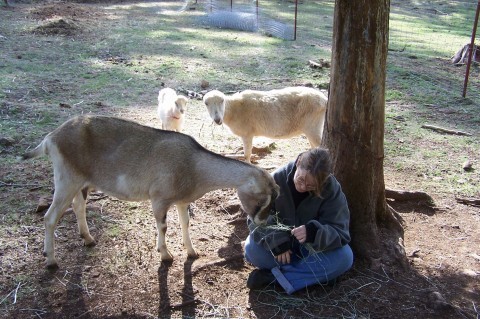
A cool fall day in Oregon, feeding Bonita while Butterfly and Abby look on. Circa October, 2006.
We mentioned the idea to Ben’s son, Noah, who turns fifteen next month. He was home from the Maine School of Science and Math this weekend, and we dragged him around with us looking at potential homes. Including some of those grand old colonials in Bath.
“Where would you keep the goats?” Noah wanted to know immediately.
“For a house like this, we’d have to compromise on the goats. Maybe chickens –”
“I can’t cuddle chickens! Why are we even looking at these places?”
Noah hasn’t allowed anyone to cut his hair since he was nine. He does things like decide he’s going to build his own calculator or video game controller on school breaks — and then does it. He spends long hours watching YouTube how-to videos about things I will likely never understand. He’s pretty awesome, actually, but I had no idea he was looking forward to cuddling our goats.
Which means goats are back on the list. And chickens — ideally, ex-battery hens, as we’d like to do some farm animal rescue. We’re entertaining the idea of doing a vegan airbnb (“Why don’t you just call it a B&B?” asks Ben, every time I say this. “Because a B&B is more commitment,” I say, “and it’s for old people. Airbnbs are fresh and new, and we can do them whenever and however we want.”) I want space so my nieces can come and stay. And, of course, we need space for Noah. We both want fresh veggies from our own garden.
It feels like an endless list, but we’ve already begun the process of evaluating our priorities and compromising accordingly. We’re working with a stellar realtor at RE/Max who was recommended by a friend of mine, and she’s already proving invaluable in giving us some insight into the market. We’re both agreed that, ultimately, the most important thing is that we find a safe, leak-free, affordable home that we can both fall in love with.
And, also, goats.
Jen Blood is author of the USA Today-bestselling Erin Solomon mysteries and the Flint K-9 Search and Rescue mystery The Darkest Thread. You can learn more about her at www.jenblood.com.
March 22, 2017
A Peek Through My Window
Dorothy Cannell: As I write this a fine snow is coming down, dusting the garage roof with confectioner’s sugar and powdering the driveway. The road that runs in front of our house is empty of traffic, tranquil, still, left to itself and its own thoughts without being nudged into activity. A need we all have at times. I don’t mind that winter lingers with few signs of stepping aside for spring. I don’t want the seasons to be skimmed through in a breathless rush. Page turners are best left to books. If my husband, Julian (only have the one), and I had disliked winter, we would never have chosen a move to Maine.
 We count ourselves wonderfully fortunate that we reached a point in our lives where we could make a choice in this matter and that it turned out to be the right one for us. Some people we know still can’t comprehend why we moved here, not only because of the long winters, but also the belief that there are no lively compensations. Tell that to those here who sail, kayak, fish, hike or ski, as do many of our neighbors. As for city life? Big surprise–there is that, too, with great shopping venues, restaurants, and night life.
We count ourselves wonderfully fortunate that we reached a point in our lives where we could make a choice in this matter and that it turned out to be the right one for us. Some people we know still can’t comprehend why we moved here, not only because of the long winters, but also the belief that there are no lively compensations. Tell that to those here who sail, kayak, fish, hike or ski, as do many of our neighbors. As for city life? Big surprise–there is that, too, with great shopping venues, restaurants, and night life.
Our daughter who lives down the road from us frequently spends a weekend in Portland,  loving its energy and diversity. She also does quite a bit of nipping down to Boston. I’m planning on going with her in the near future for a prowl round Ikea and the Pottery Barn and to visit the museums. At the end of April, Julian and I will be going to Washington, DC for Malice Domestic and on from there with our friends Margaret and Joe Maron for a few days at their home in North Carolina. We also plan on going to Bouchercon in Toronto later in the year and there’ll be a visit to our older son and his family in June. Other than that we are mostly delighted to stay put.
loving its energy and diversity. She also does quite a bit of nipping down to Boston. I’m planning on going with her in the near future for a prowl round Ikea and the Pottery Barn and to visit the museums. At the end of April, Julian and I will be going to Washington, DC for Malice Domestic and on from there with our friends Margaret and Joe Maron for a few days at their home in North Carolina. We also plan on going to Bouchercon in Toronto later in the year and there’ll be a visit to our older son and his family in June. Other than that we are mostly delighted to stay put.
On Tuesday afternoon I had a doctor’s appointment and afterwards drove home thinking what a lovely little outing. It was just a routine visit and the news all good. I hadn’t needed to deal with traffic congestion in getting there or drive for what seemed like three hours around a parking lot in increasingly desperate hope of finding a parking space of sufficient dimension that if I got out of the car and tilted it on its side I could make it fit. Even happier was the short wait before being beckoned out of the waiting room and after the usual blood pressure taking, pulse taking, etc., was told that the doctor would be in directly, which he was. I like him a lot. He’s kind, listens, talks to me rather than at me, but even had he been the loveliest person in the world, I wouldn’t have come away with the warm feeling I did had I entered his office in a frazzled state of mind from just getting there.
I have always been glad to be rooted in the ordinary, drawing strength from it in difficult times and contentment in the good ones. In the little Maine community where I am now rooted I have the external quiet to notice the space in which to pluck small joys – like daisies from undisturbed grass. It is the same with my husband Julian. One of the small things he really enjoys is picking up our two grandchildren on weekday mornings on his way to exercising at The Y. There’s not a lot of conversation given the earliness of the hour, but it’s time with them he would not otherwise get.
 Our fourteen-year-old granddaughter spent this past weekend with us. On Saturday afternoon she and I went to Hannaford to do some grocery shopping and in passing through the cleaning aisle she spotted some Clorox Cleaning Wands. On pointing them out. she told me a friend of hers had one and just loved it, and when I offered to buy her one for her bathroom she glowed. And so did I when it went in the shopping cart. We have always been close, but I knew at that moment that she shared with me the little joys of everyday.
Our fourteen-year-old granddaughter spent this past weekend with us. On Saturday afternoon she and I went to Hannaford to do some grocery shopping and in passing through the cleaning aisle she spotted some Clorox Cleaning Wands. On pointing them out. she told me a friend of hers had one and just loved it, and when I offered to buy her one for her bathroom she glowed. And so did I when it went in the shopping cart. We have always been close, but I knew at that moment that she shared with me the little joys of everyday.
The snow is still drifting down and the road beyond my front windows remains left to its own thoughts. This is my setting. I got to choose it as those of us who write fiction get to choose the ones to fit our plots and characters. In both cases, mine are much the same. I have to live in my books for months at a time, sometimes longer, and need to make myself comfortable. I do this by stepping into what I know, what I like, because that is what clears the space to fuel me with the energy to create situations not of my own experience. If I were to put myself in an environment, such as a big city cluttered with unknown material facts, I’d have to expend energy exploring them rather than getting down to propelling the story along by making things up. Of course, if it were my passion to write a mystery set in Manhattan or San Francisco, I’d do it – although the result wouldn’t be much to brag about.
I want to write ‘cozies,’ and I’m happy with the sometimes despised term. For me, it’s an embrace of setting, not pallid plots and tepid murders. It’s about beginning from a place sufficiently small and quiet to make for more of a jolt than might be the case somewhere life is on the surface more complex. Suppose a woman with too much time on her hands were to stand staring out her front windows and see that the snow had stopped falling and wonder if what was lying in the otherwise deserted street might be a body….?
Dorothy
March 21, 2017
Welcome Maine Author Sandra Neily
by Barb, in her last post from Key West, beginning the long trek back to Maine at the end of the month
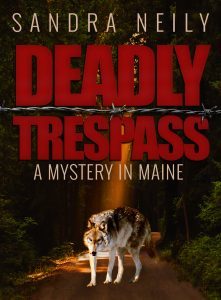 Please welcome my guest, Sandra Neily. Sandra’s debut mystery, Deadly Trespass, is up on Kindle and will soon be released in paperback. Before it was published, Deadly Trespass won a National Mystery Writers of America award, was a national finalist in the Women’s Fiction Writers Association’s “Rising Star” contest, and won honorable mention in Maine’s Joy of the Pen contest. Sandy’s blog ValueNature supports her novels’ themes.
Please welcome my guest, Sandra Neily. Sandra’s debut mystery, Deadly Trespass, is up on Kindle and will soon be released in paperback. Before it was published, Deadly Trespass won a National Mystery Writers of America award, was a national finalist in the Women’s Fiction Writers Association’s “Rising Star” contest, and won honorable mention in Maine’s Joy of the Pen contest. Sandy’s blog ValueNature supports her novels’ themes.
Sandra is a Maine neighbor of mine, a certified native of East Boothbay, growing up behind the shipyard when endless woods stretched all the way up the Damariscotta River. She now divides her time between Westport Island and Greenville; between the Sheepscot River and Moosehead Lake.
Take it away, Sandra.
Kneeling On Deer Droppings: The Idea

The author, outside
You just never know when the light bulb will go off. Or the loud click in the ear. Or the moment you slap yourself up the side of the head.
Personally, I need to be outdoors to have that kind of moment.
The click and head slap that gave birth to my novel Deadly Trespass came after I asked my daughter to kneel in a deer yard. (It’s where deer gather under tall trees that shelter them from wind and deep snow—where they can move about to find food.)
“You want me to kneel on deer poop?” she whined.
“It’s frozen,” I said. “We need a deer’s point of view and you have the camera.” (She did. See tiny black dots on the snow.)

deer yard, healthy
The day before, snowshoeing by the Kennebec River, I’d seen too much light filtered through too few trees and found the cut. Dragging my daughter back to document the remnants of the yard and the tree-harvesting behavior that had destroyed it, was our next day’s outing.
After her pictures made their way to the Bangor Daily News, I returned to the destroyed yard, this time with a BDN reporter and men who managed the cutting operations for a gigantic corporation that seemed to own more land than anyone else in the U.S.
A young photographer in fashion-y boots shivered in the deep snow and bitter wind. “Good point,” I said, probably too loudly. “Without trees, deer probably feel just like she does. Only later she gets a warm shower and hot tea. Deer just get weak and die.”
The cutting men glared at me, but they really weren’t happy when I unfolded two maps. The first map was a state agency map marking the site as important wildlife terrain. The second was a map from the cutting men’s real estate division that placed dozens and dozens of new condos in what has become a cleared lot. Two maps. Same place.

deer yard, destroyed
“So,” I asked, “if you eliminate the deer yards here, when the time comes to get a building permit for all these condos, it’s quite likely there won’t be any important wildlife habitat to stop those condos. Right? You’re getting rid of the yard and the deer so you can build without pesky animal problems. Right?”
Just the wind and the shivering woman stamping her feet.
At home over hot tea and feet too close to the wood stove, I thought about how that timber corporation bought many, many full-page BDN ads, and it was unlikely anyone would see what happened to the deer, or the woods next to the river, or just about anything far from the road or an electronic device. Far away from most eyes, close to nine million acres of Maine’s commercial forest was being stripped of anything that looked like a grown-up tree.
So why would anyone care if dying deer and disappearing forest were just another opinion piece in a paper or another on-line rant?
Why was the loss of a large chunk of Maine’s forest hidden? Such a mystery to most folks?
Click. Slap.
What if I embraced the mystery? Wrote a genuine, page-turner mystery? (Well, that was easier said than done. Understatement.) Millions of people read mysteries. And what if I flipped the script? Allowed wildlife to fight a fair fight against what made the woods not woods?
What would happen if dead bodies and wolves and Maine things tons of people cared about (whether they lived here or not), got all crowded together so a reckoning was guaranteed? If I could put readers into the woods, take them on a field trip while they remained warm at home?
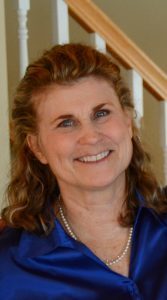
Sandra Neily
Click. Slap. Write a murder mystery that kills both people and Maine’s woods—and maybe a wolf or two. Click. Slap. Deadly Trespass.
Hibernating in a cabin and covering mirrors to hide her face, Cassandra Patton Conover is about to become an outlaw. Searching for her wayward dog in Maine’s dense woods, she finds her best friend Shannon crushed under a tree, tracks larger than any animal she knows, and a mystery only wild animals can help her solve.
Readers: Has that lightning bolt of an idea ever struck you? Share your “click” and “slap” moments.
Save
Save
Save
March 20, 2017
A Deep, Dark, Stunningly Atmospheric Work
Note from Kate: A few years ago, I was asked to look at a draft novel and give the author some advice. That author was Drew Yanno and the book was In The Matter of Michael Vogel. I was impressed. Advised. And the book was published. Then I was asked to look at his second novel, The Smart One. John Clark looked at it, too, and we were completely blown away. I found it a “can’t put it down” page turner that left me stunned by his talent. I hope you’ll grab the book after you read about Drew, and be as impressed as I was.
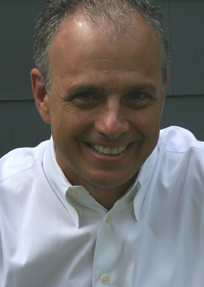 Meet Drew Yanno:
Meet Drew Yanno:
Drew Yanno was born and raised in upstate New York and received both his undergraduate and law degrees at Syracuse University.
After serving a clerkship in Albany, New York, Drew joined a large law firm in Boston where he worked for several years before founding his own firm. Throughout his time as a lawyer, Drew also taught law in the Carroll School of Management at Boston College.
In 1993, Drew began writing screenplays. Two years later, his screenplay, No Safe Haven, was purchased by Universal Studios after an eight-hour bidding war. Following that, Drew went on to write a number of screenplays, both on spec and for hire.
In 2000, Drew founded the screenwriting program in the Film Department at Boston College where he taught for eleven years.
In 2006, his book The Third Act: Writing a Great Ending to Your Screenplay was published by Continuum International Publishing Group. In 2012, his second book Idea to Story to Screenplay: a Workbook for Writing the First Draft of Your Screenplay was released as a Kindle e-book.
In addition to writing, Drew has worked as a script consultant for a number of writers, producers and directors, including Will Smith and Overbrook Entertainment.
In the Matter of Michael Vogel was his first novel. His latest thriller is The Smart One.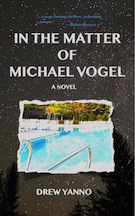
What inspires you to write?
I don’t know if inspiration is the right word. I have just always wanted to write. When I was a boy, I read all the time and was fascinated by the notion that someone could actually write an entire book, especially a novel. After becoming a lawyer, I experimented and wrote a couple of novels, just for the exercise, to see if I could do it. After having done that, I knew that I would eventually do it for real. In the meantime, I happened to get approached to write a screenplay, and following some success in that area, I was able to leave the practice of law and write full time. I also was approached to teach writing, which only further reinforced my desire to write. In all that time, I have written and will continue to do so, in some form or another.
Tell us about your writing process.
As a screenwriter, I was most definitely an outliner. Nearly every successful screenwriter outlines before writing a script. Because of the structure of Hollywood films and the limited number of pages/time you have to tell a complete and rich story, you simply have to plan ahead. You have to know where you’re going before you can even begin the script. In many ways, it’s like a lawyer preparing for a trial. You need to tell a story and manage the outcome.
On the other hand, I do no outlining at all when writing a novel. I find it a much more freeing form of written expression. While I might have some idea of where I might be headed when writing a novel, I trust the writing to lead me to “discover” the story. All the magical moments in a novel happen without planning, at least in my experience.
I don’t create or use character sketches. I take notes as I write and might jot down ideas about my characters that I will want to use later on or to remind myself of something about a character for continuity sake, but no sketches.
Your latest book is The Smart One. Tell us a little about the book and where the idea for this book came from?
It’s a modern-day thriller set in the northeast, although the story takes the main character halfway across the country and back. It’s really a story about identity and who we are, told through the voice of an unnamed narrator who is struggling with some failure as he has grown older. I can’t really tell you where the idea came from without giving away a few surprises in the book, but suffice it to say that with both this book and my first, I sort of followed the advice of Stephen King in his wonderful book On Writing and took two separate ideas and combined them.
Many writers struggle with the process of translating an idea into a written story. What is your process?
Well, with screenwriting, there is almost always outlining, as I mentioned before. When I write a novel, I simply start with an idea and just let the story take me for a ride. In The Smart One, the first 30 pages or so came to me all at once and not much changed from the first draft to the last. And it set me off on a road to discovery. I kind of like the feeling of not knowing where I’m going, figuring that if I don’t know, the reader is unlikely to have any idea.
How much is your process influenced by your law background? By your screen writing background?
As a lawyer, I always try to think of how the law affects many things in our life and so that has to be true with any character in the book. That said, I try to research (if necessary) and make sure it all makes enough sense, at least for the average fiction reader, although maybe not a Supreme Court justice or law professor. As for screenwriting, there are two main things. First, film is a visual medium, so when you write screenplays you quickly learn to write visually and try to make the reader “see” the story. I just do that out of habit now, as much for me as for the reader. The second thing is a bit of a drawback. Screenwriting is all about economy – saying the most in the fewest words. That’s not always a good thing in a novel, so I constantly walk the line between wanting to maintain a healthy pace, but also making sure I’m providing enough detail (and rich enough detail) to capture the reader’s imagination and get that reader to trust me as a storyteller.
As a reader, I was fascinated, in both of your books, by your amazing ability to control the tone of the stories. Can you talk a bit about this, and perhaps give an example?
 I’m not sure I can give an example except by saying what I did in both stories. I had such a clear idea of who the narrators were that I could hear their voices in my head and I always strived to stay true to them. In my first book (In the Matter of Michael Vogel), one of the three narrators is a twelve year old boy, and I always had to be mindful of just how sophisticated and worldly he should be. He couldn’t sound too adult. At the same time, he was described as being pretty smart and so that gave me some leeway. Luckily, it was part of the story so it didn’t feel artificial to me, and hopefully the reader as well. In The Smart One, the narrator is also “smart,” but he is in a professional rut and questioning himself to a large degree. He was never going to be jolly, and I pictured him as someone who has trouble with emotions. That helped me to maintain a certain tone throughout the story.
I’m not sure I can give an example except by saying what I did in both stories. I had such a clear idea of who the narrators were that I could hear their voices in my head and I always strived to stay true to them. In my first book (In the Matter of Michael Vogel), one of the three narrators is a twelve year old boy, and I always had to be mindful of just how sophisticated and worldly he should be. He couldn’t sound too adult. At the same time, he was described as being pretty smart and so that gave me some leeway. Luckily, it was part of the story so it didn’t feel artificial to me, and hopefully the reader as well. In The Smart One, the narrator is also “smart,” but he is in a professional rut and questioning himself to a large degree. He was never going to be jolly, and I pictured him as someone who has trouble with emotions. That helped me to maintain a certain tone throughout the story.
What advice would you give other writers?
I’m hesitant to give unsolicited advice, but I guess this qualifies as solicited. My biggest bit of advice to writers is to read. Sounds simple, I know, but I actually know some folks who claim to want to write novels, for instance, and yet they don’t read novels. That’s kind of insane to me. I think writers should read everything, but in particular, they should read what they hope to write. For example, if you want to write romance, read romance novels. If you want to write Young Adult, you better read a lot of Young Adult.
I’d also tell them to stick with it if it’s what they really want to do. Nobody succeeds on their first try or with their first draft. If it’s what you want to do, continue to write until you get there. You will get better and success, in some form or another, will come.
I know that the journey to publication has been a frustrating one for you. Can you talk a little about that journey, and your decision to try indy publishing?
With the first book, after about two years of seeking agents and having them tell me how great the book was but that they just wouldn’t be able to sell it, I finally just took matters into my own hands. And I’m happy I did. I have been blessed with some very nice reviews, including one from Kirkus, so I guess the agents were kind of right about the great part.
With the second, I had an agent who tried to get it published with the large, legacy publishers. Over the course of that, we had some disagreement about how the story should end, and after doing it her way and not getting an offer, I rewrote it the way I wanted it to end and went the independent route again. I can’t help but wonder what might have happened (or still might happen) with a marketing department and budget behind the books, but in the end I decided I simply needed to satisfy myself and be true to the stories I wanted to tell.
What do you think about the future of book publishing?
I think the stigma of self-publishing and independent publishing has pretty much vanished. It’s much more of a meritocracy now. The market, not some publishing executive somewhere, now decides what the public wants with respect to reading for pleasure. Obviously, there are advantages to being published by a traditional publisher. However, there are just as many advantages to having control over one’s material, both in its creation and its marketing.
I believe both models will co-exist for a time. However, the more reticent the traditional publishers become about taking chances on authors and material, the more that the independent and self-published authors will rush in and fill that void. The demise of the big box book retailers seems to signal an inability for them to dominate the market as they once did. Eventually, the ability to publish outside the traditional model with success will have to have a toll and may even lead to the extinction of traditional publishers, although I don’t see that happening anytime soon. Again, the market will decide. And with new outlets to help generate word of mouth and global connectedness via the internet, it will be easier for smaller books and newer authors to be discovered. It’s already happened. Sites like Book Goodies and others like it are leading the way on that. I, for one, am grateful that they exist.
What formats are your books in?
Both eBook and Print
Website(s)
Author Home Page Link
Link To Author Page On Amazon
Your Social Media Links
http://www.goodreads.com/author/show/372703.Drew_Yanno
https://www.facebook.com/InTheMatterOfMichaelVogel
https://twitter.com/drewyanno
March 19, 2017
What We’re Reading
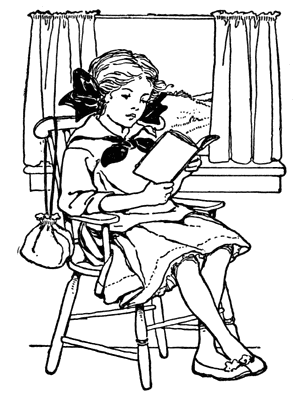
What We’re Reading
From time to time, it’s fun to check in with our writers and see what they’re reading, Here is what some of us are reading during this gloomy, snowy, yes, we’re sick of it, Month of March:
Lea Wait: I’ve just finished binge-reading all of Christina Baker Kline’s novels. Several years ago I fell in love with her ORPHAN TRAIN: two interwoven stories, one of which is about a woman who’s history is tied to the Orphan Trains, which I knew quite a bit about. Baker Kline brought history together with a contemporary story — set in Maine – and it really worked. My copy’s been sitting on my “books to emulate and learn from” shelf in my study. I pre-ordered her A PIECE OF THE WORLD, which was just published, and I wasn’t disappointed. Her interweaving of the lives of three real people – Andrew and Betsy Wyeth and Christina Olson – was even better than I hoped, capturing Maine and the frustrations and hopes of those whose lives are outside the norm. Now totally captivated, I went back and bought copies of Baker Kline’s first four books … two of which (DESIRE LINES and THE WAY LIFE SHOULD BE) are also set in Maine. (The other two are SWEET WATER and BIRD IN HAND.) Two of these books (SWEET WATER and DESIRE LINES) contain secrets that must be unearthed, although neither is a conventional mystery. I enjoyed all six of her books. They are well-written and realistic, and “got” the different Maines portrayed. But – A PIECE OF THE WORD is still my favorite. I’m going to read it again very soon. This time more slowly.
Kathy Lynn Emerson: I have the great honor to have been asked to give a quote to fellow MCW Jessie Crockett for the first book in her new series w/a Jessica Ellicott. I’ve just started MURDER IN AN ENGLISH VILLAGE, set in England in 1920. It features two female sleuths, one English and one American and I can already tell you that my blurb will be glowing. As for other reading, my interest in sixteenth century women has me dipping into Susan E. James’s WOMEN’S VOICES IN TUDOR WILLS, 1485-1603: AUTHORITY, INFLUENCE AND MATERIAL CULTURE. That probably sounds like a slog to most people, but it’s full of fascinating trivia and, of course, fodder for situations in future historical mysteries. On a lighter note, I’ve read a couple of new cozies, Miranda James’s TWELVE ANGRY LIBRARIANS and Sheila Connolly’s CRUEL WINTER.
Kate Flora: Despite making a resolution to do more reading, I haven’t been. So, for our current vacation, I bought a kindle so that I could carry books with me everywhere, and read more easily in sunlight. And I used a program called “Overdrive” through the library to load it with books. As part of trying to understand the current national divide, I read Hillbilly Elegy, about a guy with West Virginia and Ohio roots who became a marine and then went to Yale Law School. A fascinating sociological study of his rural, blue-collar extended family. Just before that I read A Man Called Ove, by Frederik Bachman, which was so charming I immediately read another of his books, My Grandmother Asked Me to tell You She’s Sorry. Now, because I heard him interviewed on NPR, I’m reading the Bruce Springsteen autobiography. Then I’m going to read some Lee Child, followed by White Trash.
Susan Vaughan: I’m reading Fear the Darkness by Becky Masterman. I was thoroughly caught up in her first thriller, Rage Against the Dying, also with Brigid Quinn, a retired FBI agent and now doing private investigations. She’s old enough to have the wisdom of experience and still strong enough to take down a threat. This story has me riveted as well. It just might keep me up at night. Here’s a little of the back cover copy: Brigid Quinn has seen more than her share of psychopaths. She is ready to put all that behind her, building a new life in Tucson with a husband, friends, and some nice quiet work as a private investigator. Sure, she could still kill a man half her age, but she now gets her martial arts practice by teaching self-defense at a women’s shelter. But sometimes it isn’t that simple.
Jessie Crockett: Currently I am reading The Doodle Revolution by Sunni Brown, Borrowed Time by Roy Hattersley and everything I can get my hands on by new-to-me mystery writer Sally Spencer.
Dick Cass: I’ve just started the Ava Lee series, Ian Hamilton’s wonderful series about a Chinese lesbian forensic accountant who travels the world collecting on bad debts. A kick-ass heroine and some crazily convoluted financial schemes that rival the best long con stories I know. Start with The Disciple of Las Vegas—I’m currently halfway through the Wild Beasts of Wuhan and happy to know there are at least five more to go. Also reread the Dutch crime novelist Janwillem van de Vetering’s The Maine Massacre, part of his series involving the Dutch constabulary solving murders, this time on the coast of Maine.
Jen Blood: I’m reading Miss Peregrine’s Home for Peculiar Children, and listening to This Changes Everything: Capitalism Versus the Climate.
Barb Ross: I just finished Garden of Lamentations by Deborah Crombie. Spoiler alert: I loved it. Now I’m reading The Bertie Project, the latest in Alexander McCall Smith’s Scotland Street series. Not a mystery, but I love these gentle, funny books.
Bruce Robert Coffin: I just finished an ARC of Vaughan Hardacker’s latest thriller, Wendigo, for the purpose of giving it a blurb. An enjoyable read that I found to be a cross between William Kent Krueger and Stephen King. Currently, I’m engrossed in Autumn Imago by local author Bryan Wiggins. Wiggins’ book is a blend of strained family relationships, memories of better times, and the beauty of Baxter State Park.
Maureen Milliken: I can’t read mysteries, at least fiction, when I’m writing one, and since writing my third book in the Bernie O’Dea mystery series is taking soooo lonnnngggg (a blog post for another day), that’s quite an issue. But I CAN read non-fiction mysteries, and this week I’m reading two books about the Martha Moxley murder, GREENTOWN by Tim Dumas, which I first read when it first came out in 1998. He’s updated it quite a bit and added a lot, including the arrest and conviction of “Kennedy cousin” Michael Skakel. I also have on tap CONVICTION to finish off this week, by journalist Len Levitt and investigator Frank Garr. Levitt was hired by the Greenwich Time newspaper to do an in-depth investigation and story on the murder in 1982, then they took almost eight years to publish his story.

Martha Moxley
Why my interest? Well, aside from the fact I’ve always been interested — Martha Moxley was only a few months older than me when she was killed in 1975 and it’s a case that’s so 1970s in so many ways — it’s going to be the topic of the Crime & Stuff podcast I host with my sister, artist Rebecca Milliken. We’re recording the episode the night before you read this and it drops next weekend. It’s not my only research, but I like to be thorough, and know what I’m talking about.
And what aren’t I reading but should be and wish I was? I bought Elinor Lipman’s ON TURNENTINE LANE a few weeks ago, and have yet to get to it. She’s one of my favorite authors, but I want to be able to take the time to enjoy it.
Vaughn C. Hardacker: Just finished two by Dennis Lehane: THE DROP and WORLD GONE BY (the third in the Coughlin Trilogy). I’m also reading a couple by Carl Hiaasen, SKINK and CHOMP. If you like whacky adventure tales with an environmental message and equally wild and crazy characters but haven’t read Hiaasen you don’t know what you’re missing. A quote from the New York Post blurb for CHOMP: “Only in Florida–and in the fiction of Carl Hiaasen–does a dead iguana fall from a palm tree and kill somebody.”
Save
Brendan Rielly: I just finished reading Waking Lions by Ayelet Gundar-Goshen, an Israeli writer. It’s a suspense novel and is her first novel published in the U.S.. Neurosurgeon Eitan Green is living a wonderful life. Successful, married, two kids. Then, while driving late one night, he hits and kills an African migrant and flees the scene. But the migrant’s widow was nearby and can identify Green. She shows up at his house to tell Green that he now works for her, providing medical care to other migrants. But her motives are less than pure–she’s charging the migrants for his services. Oh, and Green’s wife is the police detective investigating the migrant’s killing. Oh what a tangled web we weave….NPR did a nice piece on it here.
John Clark: Just finished a great YA book that’s part of my Thursday Blog this week. It’s called Daughter of the Pirate King by Tricia Levenseller. Almost finished with a New Adult title called Because of Low by Abbi Glines (New adult is my newest guilty pleasure)
Brenda Buchanan: I’ve been on an Irish/Scottish/British crime fiction kick for a while. Ann Cleeves’s THIN AIR, the sixth in her Shetland series, was terrific. The same must be said for Tana French’s most recent, THE TRESPASSER, though you need to be patient because this particular tale of the Dublin murder squad unfolds slowly. I’ve also been reading my way through Deborah Crombie’s wonderful series featuring Gemma James and Duncan Kincaid. I’m up to NOW MAY YOU WEEP (2003). When we head to Ireland next month I feel quite certain I’ll tuck a nice, dark Ken Bruen into my suitcase to read while I’m there. PURGTORY, I think, because I love Jack Taylor and though we won’t visit Galway this trip, we’ll be close enough.
Closer to home I thoroughly enjoyed William Kent Krueger’s MANITOU CANYON, flew through Michele Dorsey’s terrific PERMANENT SUNSET and am now in the middle of Ingrid Thoft’s IDENTITY. A few months ago Chris Holm’s compelling and terrifying RIGHT RIGHT HAND kept me awake at night, in a good way.
Next on my to-read list is Chris Bohjalian’s THE SLEEPWALKER and Barb Ross’ ICED UNDER, which has been out since December, but like the last caramel sea salt chocolate in the box, I’ve been saving it up.
March 17, 2017
Weekend Update: March 18-19, 2017
 Next week at Maine Crime Writers, there will be posts by Kate Flora (Tuesday), Barb Ross (Wednesday), Dorothy Cannell (Thursday) and Jen Blood (Friday). On Monday, we will have a group post on What We’re Reading.
Next week at Maine Crime Writers, there will be posts by Kate Flora (Tuesday), Barb Ross (Wednesday), Dorothy Cannell (Thursday) and Jen Blood (Friday). On Monday, we will have a group post on What We’re Reading.
In the news department, here’s what’s happening with some of us who blog regularly at Maine Crime Writers:
Bruce Robert Coffin will be appearing at the York Library, 15 Long Sands Road, York, ME on Tuesday, March 21st at 7 pm.
Reminder: You’ll find many of us Maine Crime Writers at the Maine Crime Wave on April 22. For more information and to register, click here.
An invitation to readers of this blog: Do you have news relating to Maine, Crime, or Writing? We’d love to hear from you. Just comment below to share.
And a reminder: If your library, school, or organization is looking for a speaker, we are often available to talk about the writing process, research, where we get our ideas, and other mysteries of the business. Contact Kate Flora
Save
March 16, 2017
Where Do Ideas Come From?
Over the past sixteen years I’ve made a lot of appearances as an author. I’ve spoken to kindergarten students and senior citizens, other writers and “pre-published” authors, library patrons, school groups, conferences, festivals …. a lot of people, in a lot of places.
And when it comes times for questions (my favorite part of presentations) one question always comes up: “Where do you get your ideas?”
Of course, I’m tempted to say “They’re on special, this week only, at Wal-Mart. Aisle five.” 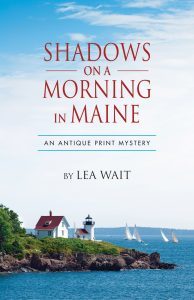 But I don’t. Because whoever is asking the question is serious.
But I don’t. Because whoever is asking the question is serious.
But there’s no easy answer. To start, authors get ideas from their own lives. I write the Shadows Antique Print mystery series because I was an antique print dealer for 35 years. My protagonist in that series wants to adopt an older child. I adopted four. But, on the other hand, I’ve never solved a crime, or found a body, or taught in a college or opened an antiques mall. Maggie Summer, my protagonist, has done all of those things. So I researched a lot of situations she could be involved with.
When I started writing the Mainely Needlepoint series, I needed to come up with all new characters and a new location. Angie Curtis spent ten years in Phoenix, Arizona — a city I’ve visited perhaps a dozen times, where one of my daughters attended college, and where a nephew-by-marriage and his wife live now. Now Angie’s home in Haven Harbor, a town similar to many small Maine seaports, from Belfast to Searsport to Boothbay Harbor.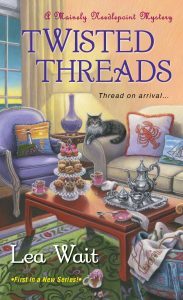
For each book in the series I’ve pulled some plot details from “real life” — mine or other people’s.
A body was really found in a freezer in a storage locker in Maine a few years back. (Twisted Threads.)
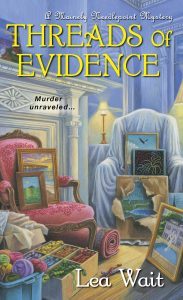 I’ve always been drawn to old, neglected and forgotten, homes, especially Victorians — like Aurora, in Threads of Evidence. And I was a drama major in college, studied improvisational theatre in New York City, and was once married to a comedy writer who worked with well-known comedians and actors. So, creating famous actress Skye West was an easy leap. Skye’s son Patrick is an artist: so was my mother, and so is my husband. I’ve spent many hours at art galleries and openings.
I’ve always been drawn to old, neglected and forgotten, homes, especially Victorians — like Aurora, in Threads of Evidence. And I was a drama major in college, studied improvisational theatre in New York City, and was once married to a comedy writer who worked with well-known comedians and actors. So, creating famous actress Skye West was an easy leap. Skye’s son Patrick is an artist: so was my mother, and so is my husband. I’ve spent many hours at art galleries and openings.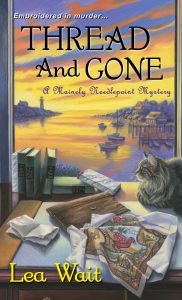
My own home is the Marie Antoinette House that was owned by the Clough family, and which is where an early piece of needlepoint is found in Thread and Gone. Mary Queen of Scots might have been a distant relative of mine, and I knew her story well. She also ended up in my book.
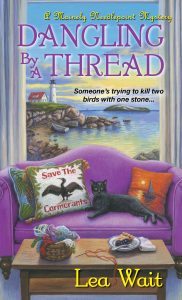 When I was a child I saw a man who lived alone on a barren island off the coast, rowed into town occasionally for supplies, and who rarely spoke with people. I was fascinated by him then, and his story (or lack of one) stayed with me through the years. I created Jesse in Dangling By a Thread to give that man I’d seen as a child a back story and a purpose.
When I was a child I saw a man who lived alone on a barren island off the coast, rowed into town occasionally for supplies, and who rarely spoke with people. I was fascinated by him then, and his story (or lack of one) stayed with me through the years. I created Jesse in Dangling By a Thread to give that man I’d seen as a child a back story and a purpose.
Australian Sarah Byrne is an antique dealer in Haven Harbor because the real Sarah Byrne is an Australian who won naming rights to one of my characters in a Bouchercon 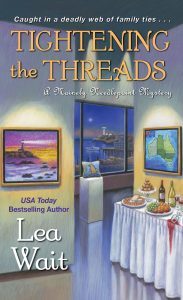 auction. I knew some day I’d have to explain what brought Sarah to the coast of Maine. As a long-time adoption advocate, I’m drawn to adoption and foster care situations, and children who need rescuing. Several years ago I happened to find a movie on Netflix called Oranges and Sunshine, about the horrible “child migrant” program which took children from England and transported them to Australia and other countries. I knew immediately that somehow Sarah was connected with that program, and further research showed me how that could be. Tightening the Threads, which will be published in ten days, is Sarah’s story, about her longing for family, and her quest to discover her roots. And, since it’s a mystery: what happens after she finds them.
auction. I knew some day I’d have to explain what brought Sarah to the coast of Maine. As a long-time adoption advocate, I’m drawn to adoption and foster care situations, and children who need rescuing. Several years ago I happened to find a movie on Netflix called Oranges and Sunshine, about the horrible “child migrant” program which took children from England and transported them to Australia and other countries. I knew immediately that somehow Sarah was connected with that program, and further research showed me how that could be. Tightening the Threads, which will be published in ten days, is Sarah’s story, about her longing for family, and her quest to discover her roots. And, since it’s a mystery: what happens after she finds them.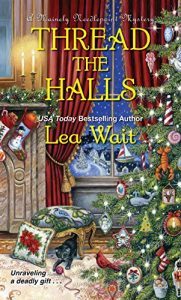
Thread the Walls, to be published next October, brings actress Skye West back to Haven Harbor from her movie set in Edinburgh (which I have visited), along with some of her show business colleagues. The weather, the food they eat, the way they celebrate Christmas (minus the requisite murder, of course) are all very familiar to me.
All these stories, and the others I’ve written, started with a glint. An idea. A question. A fact. And then I asked a lot of questions (what if? how? why?) and did research to connect the dots and create characters who could ask some of the same questions.
Research is one of my favorite parts of writing (the other is editing) and maybe that’s why I write mysteries: solving a crime requires a lot of questions and a lot of research. Isn’t that what an investigation is?
So, how do I get my ideas for plots and characters? Our of real life; out of my imagination; and, best of all, from the glint of an idea for a plot and from the characters themselves, who lead me to the story. Not just “what happens next” and “who done it” but why? Because the emotional context of that “why” is the real basis for any mystery.
Thanks for asking!

